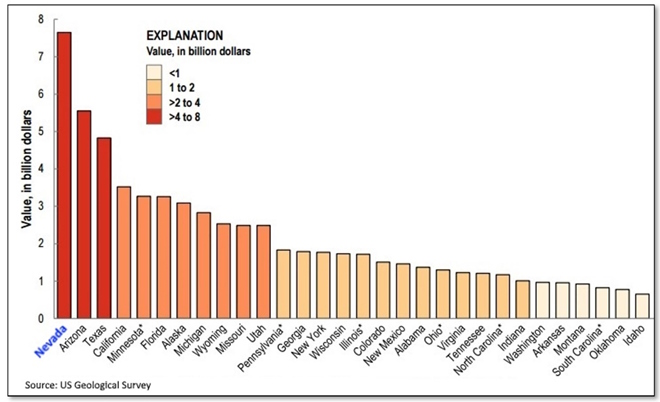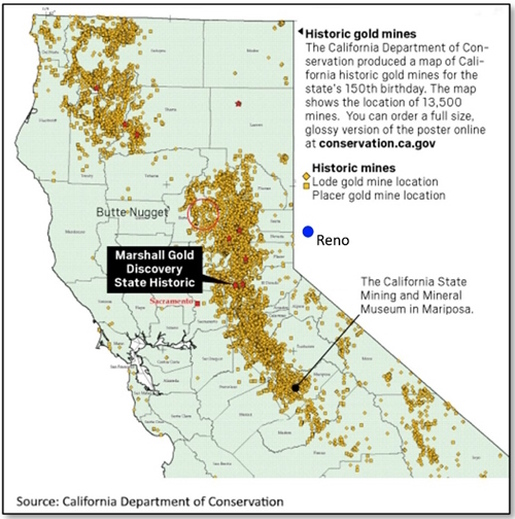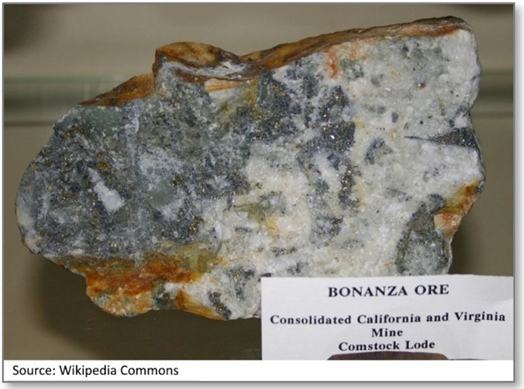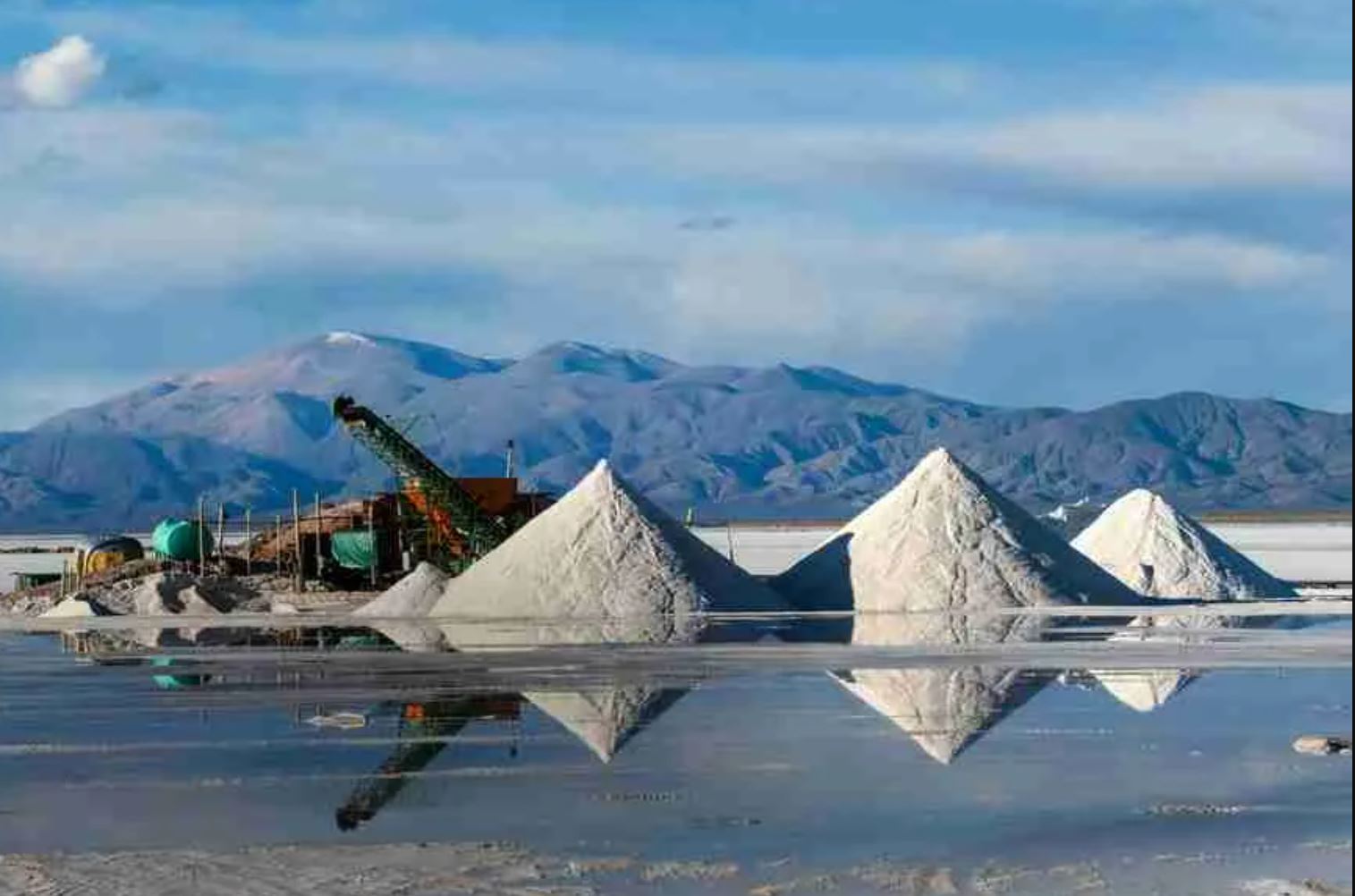Nevada Gold and Silver Mining
While most Nevadans know that mining is a major industry in the state, probably few are aware that we are the largest producer of non-petroleum minerals of the Unites States. Nevada accounts for over ten percent of overall U.S. mining and production.

However, what may be more surprising is that, while Nevada’s share of U.S. silver production is about twenty percent (second, behind Alaska), for gold that portion is a staggering seventy five percent, or about 4.5 percent of total world production. Clearly, our nickname of “The Silver State” can be attributed more to the historical record than the current situation! Ironically, “The Golden State” of California accounts for just over two percent of current U.S. gold production and has only one remaining operating mine. The history that led to these state nicknames was of course tied to the great California gold rush of 1849 in the Sierra Nevada, and Nevada’s Comstock Lode discovery near Virginia City in the decade that followed. Both sites have since largely exhausted their economically recoverable deposits but their places in American mining history are so profound that the states have retained their nicknames.
 Historic gold mine sites in California |  Current gold l and silver l mine sites in Nevada The three largest gold mines l account for 52% of state production. |
As has usually been the case with precious metals for thousands of years, the first discoveries in our region were of native dust and nuggets in stream beds, so-called “placer” deposits, eroded from “mother lode” veins upstream and washed down over thousands of years. The was the case with the famous gold discovery at Sutter’s Mill, CA in 1848 and also with the discovery of gold in 1850 at Gold Canyon, near Dayton, NV. As the most easily found deposits were exhausted, these early placer miners moved progressively upstream and eventually were able to find some of the source veins, usually in combination with quartz in the hard mountain bedrock. They soon began to drill and dig shafts into these veins in search of the deeper deposits.
In fact, gold comprises only about 3 parts per billion of the earth’s crust and silver about 80 parts per billion. We are only able to find them in minable quantities due to ancient geologic processes that greatly concentrated these rare minerals in specific locations. In the case of the vein-type deposits, it was volcanic vents carrying superheated solutions upward through joints and faults in the bedrock. The precipitation of appreciable concentrations often occurred over millions of years. The cause of the volcanism was the tectonic collisions of plates along the western margin of the continent, as we have discussed in earlier articles of this series. For the Comstock Lode, these processes took place over the past few million years, which is very recent in geologic terms.
Once the Gold Canyon deposits had been traced upstream to mother lode veins at Silver City, Gold Hill and Virginia City, it was found that the majority of the ore was a blue-black rock, interspersed with quartz, containing a small amount of gold and a majority of silver sulfide. The higher portion of silver led to that metal becoming the dominant product from the region, although considerable gold was also extracted. About 7 million tons of ore was extracted during the peak production years from 1860 through 1880, with the refined silver and gold worth about $320 million at the time. That would equate to many billions of dollars today. With the prices for both metals much higher in today’s markets, the search remains for economic deposits in the area, but at present production has not resumed substantially.
| Comstock Lode silver sulfide/gold ore  | Carlin-type sedimentary origin gold ore  |
Today, the character and geography of mining in our state is quite different than in days past. The dominant deposits are in the north-central position of the state, in a geologic region known as the Carlin Trend. The volcanic period of origin is much earlier, from about 350 million years ago during the Mississippian period and in some cases even earlier. Rather than distinct veins of high concentration, the ores are more evenly distributed, mainly in sedimentary rock that was deposited during that ancient period from gold-bearing sands and gravels of the placer variety. However, the gold is rarely visible and occurs in concentrations of only about a quarter ounce per ton of ore. Mining is only economic because of modern chemical extraction methods and today’s relatively high price for gold and silver.
Most of Nevada’s silver production today comes as a by-product of gold processing. In the preceding map, the colocation of silver and gold mines in the state is very apparent.
The Carlin Trend mines are mostly of the open-pit variety and can be extremely large. This is in stark contrast to the shaft style that was prevalent in the Comstock Lode mines of the 19th century. Both types pose significant environmental impact challenges, but modern regulations require strict isolation and treatment of chemical leaching agents, as well as extensive reclamation of the land after a mine is exhausted. By contrast, no such controls were known in the nineteenth century and there are still significant traces of processing chemicals, most notably mercury, present in the soils and streams in and around the Comstock Lode mines, and even into the Truckee Meadows. Another major impact was the deforestation of the Carson Range and Lake Tahoe area due to harvesting of timber for mine construction. Fortunately, this ended over a century ago and the impact is almost impossible to see today.
Mining safety standards are another major difference between the industry of the Comstock era and today. Accidents and permanent health impacts that were once common are almost unknown today.
| Trench Mill at Silver City, NV, 1877  | Barrick Gold Cortez Mine, in the Carlin Trend  |
While we tend to think of gold and silver mainly in terms of jewelry and hard financial assets, they are both indispensable industrial metals, particularly in modern electronics. Nevada’s mining legacy makes up a rich part of the state’s history and still contributes very significantly to the healthy economy we enjoy today.



